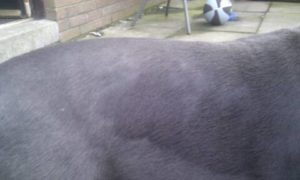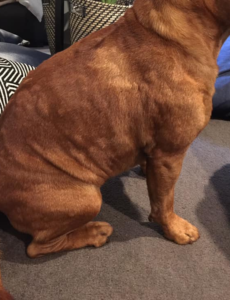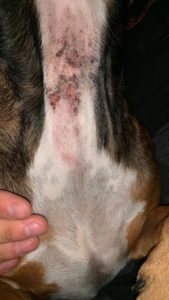Skin Health
Stafford Bull Terriers are, in general, healthy dogs with a long lifespan (15 years, more or less).
Staffordshire Bull Terriers actually have fairly sensitive skin, which can mean you’ll have to watch out for their food, shampoo and grooming products IF you notice excessive shedding or similar symptoms.
The general condition of Stafford’s skin and coat are good indicators of his health. A healthy coat should be shiny and smooth, not brittle or coarse, and healthy skin should be supple and clear, not smelly, greasy, flaky, or bumpy.
Dog’s skin is the largest organ he has, make sure it stays healthy. Your Stafford needs an adequate diet, this is the most important step of all.
Healthy skin requires a daily regime packed with products rich in fatty acids, oils, and vitamins are essential for healthy skin. Food active in pre and probiotics, vitamins, minerals, electrolytes, enzymes, protein, and fatty acids and helps reduces inflammation and allergies. It really packs a good punch when it comes to overall health for your dog.
What should a Stafford skin look like?
As humans, each dog is different, but there are some general things that should be the same for all dogs who have a healthy skin.
- Skin should be white, light pink or black, depending on the pigment of the dog.
- It should be elastic, when pinched between fingers it should straighten right back.
- Skin must be free of crusting, flaking, with no infected or hot and inflamed spots.
- Coat is directly related to skin and should be thick and shiny, without bald spots.
- There should be reasonable amount of shedding, depending on the time of the year.
Does the skin and coat depend on the colour?
The answer is yes, somewhat.
The general opinions is that blue dogs are most susceptible to skin issues, as their colour is a result of the black gene being diluted. We must say we do not have issues with blue dogs in our house, but then again we feed good quality raw food and on rare occasions some kibble.
Our experience has taught us that indeed “you are what you eat” – so our white dogs do not eat corn, beet, carrot or any food having natural or synthetic colorants, as it shows on their fur.
As skin is the biggest organ, skin is often the first to show some signs of discomfort if any part of the dogs body is lacking in nutrients, or having issues.
According to Animal Trust, most common dog skin issues are:
Skin Sores, Dry Skin, Rashes, Lumps, Redness, Dandruff, Bumps, Hair Loss
SKIN PROBLEMS
ALOPECIA
ATOPIC DERMATITIS
DEMODEX
Skin Issues
ALOPECIA
When talking about skin issues we must mention alopecia too.
In blue Staffords, there is a possibility of Color dilution alopecia (CDA). This is a rare condition that causes patches of hair thinning or loss, and may also include flaky and/or itchy skin. CDA is associated with “dilute” color, and is most commonly seen in dogs with a blue or fawn coat. While the disorder has been most commonly described in blue Dobermans, it has been recognized in other breeds as well, including Greyhounds, Salukis, Staffords and many other breeds.
The actual cause of CDA is poorly understood. Dogs with CDA tend to have abnormalities in the hair follicles themselves, causing them to self-destruct, making it impossible for them to grow new hairs. Other than her overall appearance, her health is not at risk.
However, CDA is not curable, but it is fairly straightforward to manage.
At this moment there is no test that can tell if any blue dog is a carrier of CDA and until there is, best option is to buy a blue puppy form visibly healthy parents.

ATOPIC DERMATITIS
Nowadays many dogs have fairly sensitive skin, which can mean you’ll have to watch out for their food, shampoo and grooming products. The breed is somewhat susceptible to the development of skin infections, “hot spots,” and irritations that result from poor nutrition or the use of inappropriate supplements. The Staffordshire Bull Terrier can be prone to various skin allergies, which are recognized by the fact that the dog is constantly scratching or licking, until the source of the problem is removed. To solve the problem, you will need to work with a veterinarian to control the symptoms and their impact on your dog and, if possible, determine the cause of the allergen and eliminate it. We do not practice or condemn the use of antibiotics, steroids or other traditional treatments in our daily routine. With the use of proper nutrition and boosting the dog’s immune system, we are confident that these problems will can be avoided.
More information here.

DEMODEX
DEMODYCOSIS, also known as demodex, is an inflammatory disease in dogs caused by mites. When the number of mites that inhabit the hair follicles and the dog’s skin suddenly increases, it can lead to skin lesions, skin infections and hair loss (alopecia). The severity of the symptoms depends on the type of mite.
Mites are normally normal inhabitants of your dog’s skin. In small numbers, these mites do not cause any symptoms and can play an important role as part of the normal micro fauna of the skin (just as healthy bacteria are important for digestive health).
Although demodex may appear to be associated with bull breeds, it is not uncommon in other breeds, but shows signs of a weak dog’s immune system (it can also be caused by various other disorders).
You can see more information about this disease here.
